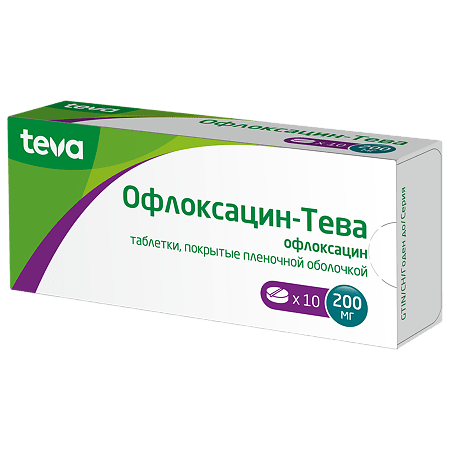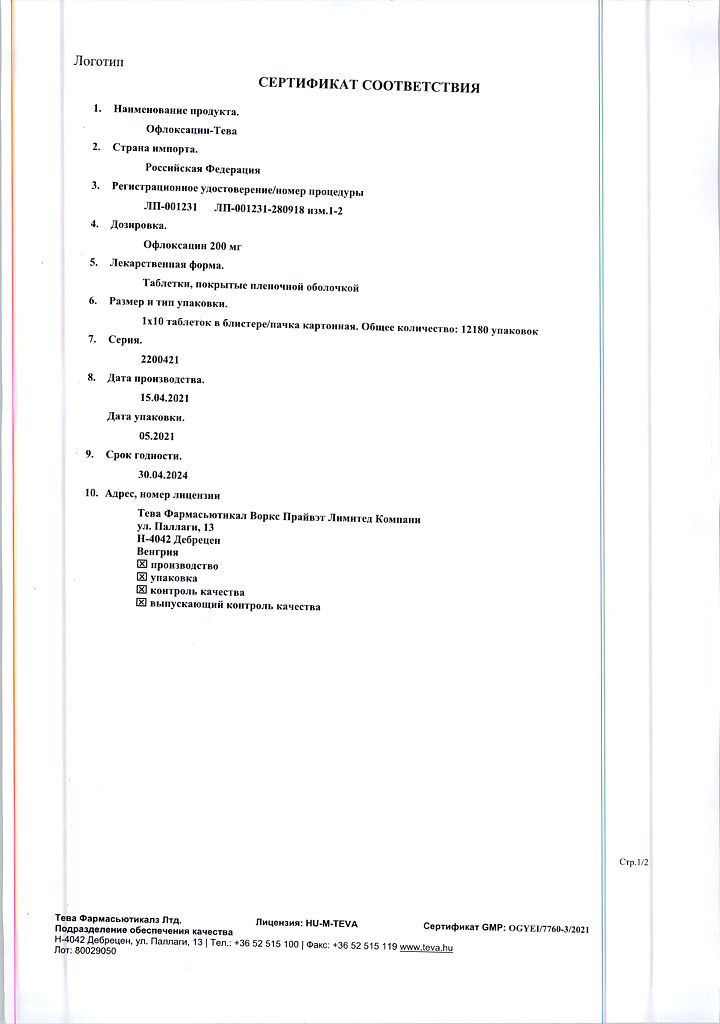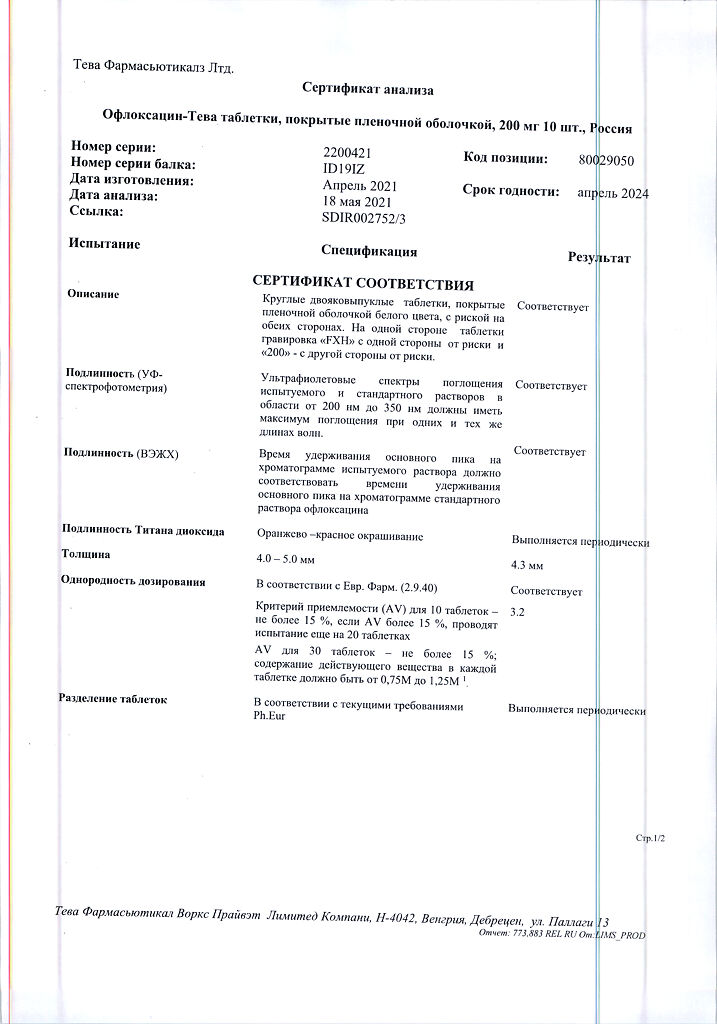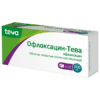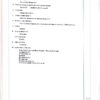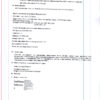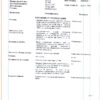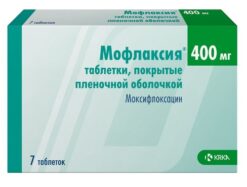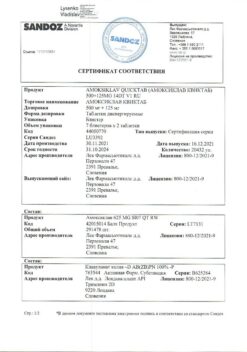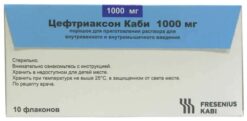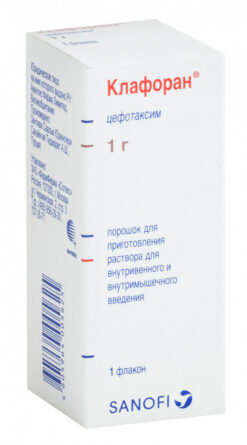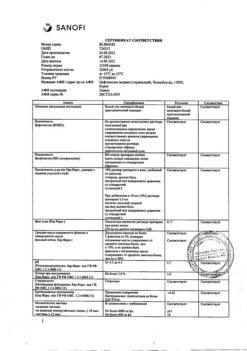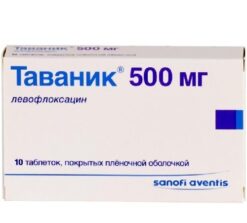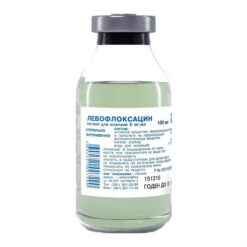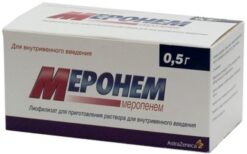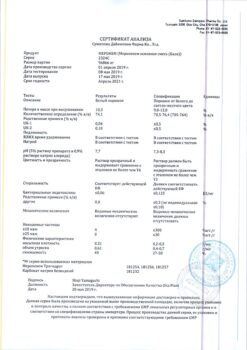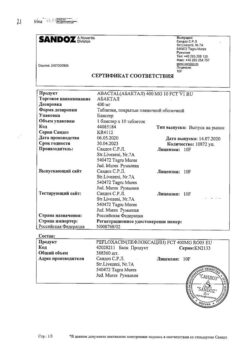No products in the cart.
Ofloxacin-Teva, 200 mg 10 pcs
€6.38 €5.67
Description
Pharmacotherapeutic group: antimicrobial agent – fluoroquinolone.
ATX code: JMA0101
Pharmacological properties .
Pharmacodynamics
Ofloxacin is a synthetic antibacterial drug of broad spectrum
from the group of fluoroquinolones with bactericidal action. The main
the mechanism of action of quinolones is specific inhibition of bacterial
DNA-gyrase. DNA-gyrase is essential for replication, transcription, repair and recombination of bacterial DNA. Its inhibition leads to the unwinding and destabilization of bacterial DNA and, consequently, to the death of the microbial cell.
Highly active against most gram-negative and gram-positive 2
microorganisms.
Fluoroquinolones have concentration-dependent bactericidal activity and
moderate postantibacterial action. The ratio of AUC to minimum
suppressive concentration (MCC) or the ratio of maximum concentration to
MCC is a predictive factor for successful clinical treatment.
Sensitive microorganisms
.Non-permanently susceptible microorganisms (possibly due to acquired
resistance): Citrobacter freundii, Escherichia coli, Klebsiella oxytoca, Klebsiella
pneumoniae, Neisseria gonorrhoeae, Proteus mirabilis, Pseudomonas aeruginosa, Serratia spp,
Staphylococcus spp. (coagulazonegative strains), Staphylococcus aureus (methicillin-
sensitive strains), Staphylococcus epidermidis, Campylobacter jejuni, Enterococcus
faecalis, Streptococcus pneumoniae.
Resistant microorganisms
Acinetobacter baumannii, Bacteroides spp, Clostridium difficile, Enterococci (including
Enterococcus faecium),
resistant strains), Nocardia spp.
Resistance
Resistance to ofloxacin develops as a result of a stepwise process of mutations
of the genes encoding both topoisomerase type II: DNA-gyraza and topoisomerase IV. Other
resistance mechanisms, such as the mechanism for influencing the permeability of the outer
structures of the microbial cell (a mechanism characteristic of Pseudomonas aeruginosa) and
the efflux mechanism (active elimination of the antimicrobial agent from the microbial
cell) can also affect the sensitivity of microorganisms to ofloxacin.
MBC limit values
The European Committee for the Susceptibility of Antibiotics (EUCAST) approved limit values (mg/L) for ofloxacin.
Microorganisms
Sensitive (mg/L)
Enterobacteriaceae .
≤0.5
>1
Staphylococcus spp.
≤1
>1
Streptococcus pneumoniae
≤0.12
>4
Haemophilus influenzae
≤0.5
>0.5
Moraxella catarrhalis
≤0.5
>0.53
Neisseria gonorrhoeae
≤0.12
>0.25
/p>
Borderline MPC values,
not associated with a specific
microbial species
≤0.5
>1
Pharmacokinetics
After oral administration, ofloxacin is rapidly and almost completely absorbed from the
gastrointestinal tract. Bioavailability is almost 100%.
The maximum plasma concentration of ofloxacin after a single dose of 200
mg is 2.5-3 mcg/ml and is reached after 1 hour. Binding to plasma proteins
is 25%. The volume of distribution is approximately 120 liters. Less than 5% of Ofloxacin
is biotransformed.
It is excreted mainly by the kidneys (80-90% of the dose is unchanged). Two main metabolites are detected in the urine: N-desmethylofloxacin and ofloxacin
N-oxide. About 4% ofloxacin is excreted with the bile as glucuronides. The elimination half-life is 6-7 hours. Concentrations ofloxacin in the urine and in
infected urinary tract exceed concentrations ofloxacin in serum
blood by 5-100 times.
Special patient groups
Elderly patients
. Elderly patients have an increased half-life, but
the maximum concentration does not change.
Renal failure
In renal failure, the half-life is prolonged; total and renal
clearance decrease in proportion to the decrease in creatinine clearance.
Indications
Indications
Treatment of infectious and inflammatory diseases caused by sensitive to
ofloxacin by microorganisms:
Pyelonephritis and complicated urinary tract infections; prostatitis, epididymitis, orchitis;
infections of the pelvic organs (as part of combination therapy);
For the treatment of the following infectious and inflammatory diseases, ofloxacin can
use only as an alternative to other antimicrobials: skin and soft tissue infections;
cystitis, uncomplicated urinary tract infections;
4 infections of bones and joints;
acute sinusitis;
exacerbation of chronic bronchitis, community-acquired pneumonia;
prevention of infections caused by those sensitive to ofloxacin
microorganisms, in patients with a significant decrease in immune status
(for example, with neutropenia).
When using the drug Ofloxacin-Teva, you should take into account official
national recommendations for the appropriate use of antibacterial agents
drugs, as well as the sensitivity of pathogenic microorganisms in a particular
region.
Pharmacological effect
Pharmacological effect
Pharmacotherapeutic group: antimicrobial agent – fluoroquinolone.
ATX code: J01MA01
Pharmacological properties
Pharmacodynamics
Ofloxacin is a synthetic broad-spectrum antibacterial drug
actions from the group of fluoroquinolones, which have a bactericidal effect. Main
The mechanism of action of quinolones is the specific inhibition of bacterial
DNA gyrases. DNA gyrase is required for replication, transcription, repair and
recombination of bacterial DNA. Its inhibition leads to unwinding and
destabilization of bacterial DNA and, as a result, the death of the microbial cell.
Highly active against most gram-negative and gram-positive 2
microorganisms.
Fluoroquinolones have concentration-dependent bactericidal activity and
moderate post-antibacterial effect. AUC to minimum ratio
inhibitory concentration (MIC) or the ratio of maximum concentration and
BMD is a predictive factor for successful clinical treatment.
Sensitive microorganisms
Variably sensitive microorganisms (possibly due to acquired
resistance): Citrobacter freundii, Escherichia coli, Klebsiella oxytoca, Klebsiella
pneumoniae, Neisseria gonorrhoeae, Proteus mirabilis, Pseudomonas aeruginosa, Serratia spp.,
Staphylococcus spp. (coagulase-negative strains), Staphylococcus aureus (methicillin-
sensitive strains), Staphylococcus epidermidis, Campylobacter jejuni, Enterococcus
faecalis, Streptococcus pneumoniae.
Resistant microorganisms
Acinetobacter baumannii, Bacteroides spp., Clostridium difficile, Enterococci (including
Enterococcus faecium), Listeria monocytogenes, Staphylococcus aureus (methicillin-
resistant strains), Nocardia spp.
Resistance
Resistance to ofloxacin develops as a result of a stepwise process of mutations
genes encoding both type II topoisomerases: DNA gyrase and topoisomerase IV. Other
resistance mechanisms, such as the mechanism of influence on the permeability of external
microbial cell structures (a mechanism characteristic of Pseudomonas aeruginosa) and
efflux mechanism (active removal of an antimicrobial agent from microbial
cells) – may also affect the sensitivity of microorganisms to ofloxacin.
MPC boundary values
MIC breakpoint values (mg/l) of ofloxacin approved by the European Committee
Antibiotic Susceptibility Test (EUCAST).
Microorganisms
Sensitive (mg/l)
Resistant (mg/l)
Enterobacteriaceae
≤0.5
>1
Staphylococcus spp.
≤1
>1
Streptococcus pneumoniae
≤0.12
>4
Haemophilus influenzae
≤0.5
>0.5
Moraxella catarrhalis
≤0.5
>0.53
Neisseria gonorrhoeae
≤0.12
>0.25
Boundary values of the MPC,
not related to specific
type of microorganisms
≤0.5
>1
Pharmacokinetics
After oral administration, ofloxacin is rapidly and almost completely absorbed from
gastrointestinal tract. Bioavailability is almost 100%.
The maximum concentration of ofloxacin in blood plasma after taking a single dose is 200
mg is 2.5-3 mcg/ml and is achieved after 1 hour. Plasma protein binding
is 25%. Distribution volume – approximately 120 l. Less than 5% ofloxacin
undergoes biotransformation.
It is excreted mainly by the kidneys (80-90% of the dose – unchanged). In urine
two main metabolites are found: N-desmethylofloxacin and ofloxacin
N-oxide About 4% of ofloxacin is excreted in the bile in the form of glucuronides. Period
half-life is 6-7 hours. Concentrations of ofloxacin in urine and
infected urinary tracts exceed serum concentrations of ofloxacin
blood 5-100 times.
Special patient groups
Elderly patients
In elderly patients, there is an increase in half-life, but
the maximum concentration does not change.
Kidney failure
In renal failure, the half-life increases; general and renal
clearance decreases in proportion to the decrease in creatinine clearance.
Special instructions
Special instructions
Disability and potential irreversible serious adverse reactions associated with fluoroquinolones
The use of fluoroquinolones, including ofloxacin, has been associated with disability and the development of irreversible serious adverse reactions from various body systems that can develop simultaneously in the same patient. Adverse reactions caused by fluoroquinolones include tendonitis, tendon rupture, arthralgia, myalgia, peripheral neuropathy, and nervous system side effects (hallucinations, anxiety, depression, insomnia, headaches, and confusion). These reactions may develop from several hours to several weeks after the start of ofloxacin therapy. The development of these adverse reactions was observed in patients of any age or without the presence of previous risk factors. If the first signs or symptoms of any serious adverse reaction occur, ofloxacin should be discontinued immediately. Fluoroquinolones, including ofloxacin, should be avoided in patients who have experienced any of these serious adverse reactions.
Kidney failure
Due to the fact that ofloxacin is excreted mainly by the kidneys, dosage adjustment of ofloxacin is necessary in patients with renal failure (see sections “Precautions”, “Dosage and Administration”).
Prevention of photosensitivity
During treatment with ofloxacin, due to the risk of photosensitivity, exposure to bright sunlight and ultraviolet rays should be avoided.
Secondary infection
As with the use of other antimicrobial drugs, when taking ofloxacin, especially long-term, it is possible to develop a secondary infection associated with the growth of
drug-resistant microorganisms, to exclude and confirm which the patient’s condition should be re-evaluated. If a secondary infection develops during therapy, the necessary measures should be taken to treat it.
Peripheral neuropathy
Sensory and sensorimotor neuropathy, which may have a rapid onset, has been reported in patients receiving fluoroquinolones, including ofloxacin. If patients develop symptoms of neuropathy, treatment with ofloxacin should be discontinued to help minimize the possible risk of developing irreversible conditions. Patients should be informed to report any symptoms of neuropathy to their healthcare provider. Fluoroquinolones should not be prescribed to patients with a history of peripheral neuropathy (see section “Precautions”).
Patients with glucose-6-phosphate dehydrogenase deficiency
Patients diagnosed with glucose-6-phosphate dehydrogenase deficiency may be predisposed to hemolytic reactions when treated with quinolones. Therefore, caution should be exercised when using ofloxacin in such patients (see section “Caution”).
Pseudomembranous colitis caused by Clostridium difficile
The appearance of diarrhea, especially severe, persistent and/or bloody diarrhea, during or after treatment with ofloxacin may be a manifestation of pseudomembranous colitis. If the development of pseudomembranous colitis is suspected, treatment with ofloxacin should be stopped immediately, and appropriate specific antibacterial therapy (oral vancomycin, oral teicoplanin or oral metronidazole) should be immediately prescribed. If this clinical situation occurs, drugs that suppress intestinal motility are contraindicated.
Patients predisposed to developing seizures
Like other quinolones, ofloxacin should be used with caution in patients predisposed to the development of seizures (patients with a history of central nervous system lesions, patients concomitantly receiving drugs that lower the threshold of convulsive activity of the brain (theophylline, fenbufen and other similar non-steroidal anti-inflammatory drugs) (see section “With caution”). If seizures develop, treatment with ofloxacin should be discontinued.
Tendonitis and tendon rupture
Tendinitis, which rarely occurs with quinolone use, can sometimes lead to rupture of tendons, including the Achilles tendon, especially in older patients and in
patients simultaneously taking glucocorticosteroids. This one is unwanted
the effect can develop within 48 hours after the start of treatment and be bilateral. Elderly patients are more prone to developing tendinitis; In patients taking fluoroquinolones, the risk of tendon rupture may be increased with concomitant use of corticosteroids. In addition, post-transplant patients have an increased risk of developing tendinitis, so it is recommended to be careful when prescribing fluoroquinolones in this category of patients. In patients with impaired renal function, the daily dose should be
adjust based on creatinine clearance. Patients should be advised to remain calm at the first sign of tendonitis or tendon rupture and to contact their healthcare provider. If you suspect the development of tendinitis or tendon rupture, you should immediately stop treatment with the drug and begin appropriate treatment of the affected tendon, for example, by providing it with sufficient immobilization (see sections “Contraindications”, “Side effects”).
QT prolongation
Some caution is necessary when taking fluoroquinolones, including
ofloxacin, in patients with known risk factors for QT prolongation, such as
How:
old age;
uncorrected electrolyte imbalance (eg, hypokalemia,
hypomagnesemia);
congenital prolongation of the QT interval;
diseases of the cardiovascular system (heart failure, heart attack
myocardium, bradycardia);
simultaneous use of drugs that prolong the QT interval (classes IA and III
antiarrhythmic drugs, tricyclic antidepressants, macrolides,
neuroleptics).
Pseudoparalytic myasthenia gravis (myasthenia gravis)
Fluoroquinolones, including ofloxacin, are characterized by neuromuscular blocking properties.
activity and may increase muscle weakness in patients with myasthenia gravis. In the post-marketing period, serious adverse reactions, including pulmonary failure requiring mechanical ventilation and death, have been observed with the use of fluoroquinolones in patients with myasthenia gravis. The use of ofloxacin in a patient with an established diagnosis of pseudoparalytic myasthenia gravis is contraindicated (see section “Side effects”).
Severe skin reactions
Severe bullous reactions such as Stevens-Johnson syndrome and toxic epidermal necrolysis have been reported when taking ofloxacin. Patients should be informed that if skin reactions and/or mucosal lesions develop, they should immediately consult a physician before continuing treatment with ofloxacin.
Hypersensitivity reactions and allergic reactions
When using fluoroquinolones, the development of hypersensitivity reactions and allergic reactions has been reported after the first use (anaphylactic shock and anaphylactoid reactions, which can progress to a life-threatening condition). In these cases, ofloxacin should be discontinued and appropriate treatment should be initiated.
Psychotic reactions
Psychotic reactions, including suicidal ideation/attempts, have been reported in patients taking fluoroquinolones, including ofloxacin, sometimes after a single dose. In case of development of any side effects from the central nervous system, including mental disorders, ofloxacin should be immediately discontinued and appropriate treatment prescribed. In these cases, it is recommended to switch to therapy with an antibiotic other than a fluoroquinolone, if possible. Ofloxacin should be prescribed with caution to patients with psychotic disorders (including a history) (see section “Caution”).
Liver dysfunction
Ofloxacin should be used with caution in patients with impaired liver function, as liver damage may occur (see section “Caution”).
With the use of fluoroquinolones, cases of development of fulminant
hepatitis leading to the development of liver failure (including fatal cases). Patients should be advised to stop treatment and consult a doctor if symptoms and signs of liver disease are observed, such as anorexia, jaundice, dark urine, itching, abdominal pain.
Dysglycemia (hypo- and hyperglycemia)
As with other fluoroquinolones, changes in blood glucose concentrations, including hypo- and hyperglycemia, were observed with the use of ofloxacin. During therapy with ofloxacin, dysglycemia occurred more often in elderly patients and patients with diabetes mellitus receiving concomitant therapy with oral hypoglycemic drugs (for example, sulfonylureas) or insulin. When using ofloxacin in such patients, the risk of developing
hypoglycemia, up to hypoglycemic coma. It is necessary to inform patients about the symptoms of hypoglycemia (confusion, dizziness, ravenous appetite, headache, nervousness, palpitations or increased heart rate, pale skin, perspiration, trembling, weakness). If the patient develops hypoglycemia, treatment with ofloxacin should be discontinued immediately and appropriate therapy should be initiated. In these cases, it is recommended to switch to therapy with an antibiotic other than a fluoroquinolone, if possible. During treatment
ofloxacin in elderly patients and patients with diabetes mellitus
Close monitoring of blood glucose concentrations is recommended.
Patients taking vitamin K antagonists
Due to a possible increase in prothrombin time/international normalized ratio and/or bleeding in patients taking
simultaneously ofloxacin and vitamin K antagonists (for example, warfarin),
Close monitoring of blood clotting parameters is recommended.
Risk of developing resistance
The prevalence of acquired resistance may vary geographically and over time for individual species. Therefore, regional information on resistance is required. Microbiological diagnostics should be carried out with isolation of the pathogen and determination of its sensitivity, especially in severe infections or
lack of response to treatment.
Escherichia coli infections
Resistance to fluoroquinolones in Escherichia coli, the most common causative agent of urinary tract infections, varies in different geographic areas. Physicians are advised to take local resistance into account
Escherichia coli to fluoroquinolones.
Infections caused by Neisseria gonorrhoeae
Due to increasing resistance in Neisseria gonorrhoeae, ofloxacin should not be used as empirical treatment for suspected gonococcal infection.
urinary tract. Susceptibility testing of the pathogen to ofloxacin should be performed to guide targeted therapy.
Methicillin-resistant Staphylococcus aureus
There is a high likelihood that methicillin-resistant Staphylococcus aureus will be resistant to fluoroquinolones, including ofloxacin. Therefore, ofloxacin is not recommended for the treatment of known or suspected
infections caused by methicillin-resistant Staphylococcus aureus, if laboratory tests have not confirmed the sensitivity of this microorganism to ofloxacin.
Bone and joint infections
For infections of bones and joints, the need for a combination should be considered.
use of ofloxacin with other antibacterial drugs.
Aneurysm and aortic dissection
Epidemiological studies have reported an increased risk of aortic aneurysm and aortic dissection after taking fluoroquinolones, especially in elderly patients.
Therefore, fluoroquinolones should be used only after a careful benefit-risk assessment and consideration of other treatment options in patients with a family history of aortic aneurysm; in patients with diagnosed aortic aneurysm and/or
aortic dissection; in the presence of other risk factors or conditions,
predisposing to the development of aortic aneurysm and aortic dissection (eg,
Marfan syndrome, vascular Ehlers-Danlos syndrome, Takayasu arteritis, giant cell arteritis, Behçet’s disease, arterial hypertension, atherosclerosis).
In case of sudden pain in the abdomen, chest, or back, patients should immediately consult a doctor at the emergency room.
Effect on laboratory parameters and diagnostic tests
Ofloxacin may inhibit the growth of Mycobacterium tuberculosis, leading to false-negative results in the bacteriological diagnosis of tuberculosis.
When determining opiates and porphyrins in urine during treatment with ofloxacin, a false positive result is possible. It may be necessary to confirm positive results using more specific methods.
Other
During the treatment period, it is not recommended to consume ethanol.
Impact on the ability to drive vehicles and machinery
Some adverse reactions, such as dizziness/vertigo, drowsiness and blurred vision, may reduce psychomotor response and ability to concentrate and therefore increase the risk in situations in which the presence of these abilities is especially important (for example, when driving a car or other machinery).
Active ingredient
Active ingredient
Ofloxacin
Composition
Composition
1 tablet contains: active ingredient ofloxacin 200.0/400.0 mg;
excipients: lactose monohydrate 105.6/211.2 mg, starch
pregelatinized 54.0/108.0 mg, hypromellose 20.0/40.0 mg, croscarmellose sodium
16.0/32.0 mg, colloidal silicon dioxide (anhydrous colloidal silicon dioxide)
0.4/0.8 mg, magnesium stearate 4.0/8.0 mg, Opadry II white shell 33G28707 (hypromellose-
6cP 6.00/9.60 mg, titanium dioxide E171 3.60/5.76 mg, lactose monohydrate 3.30/5.28 mg,
macrogol-3000 1.20/1.92 mg, triacetin 0.90/1.44 mg).
Pregnancy
Pregnancy
Pregnancy
Ofloxacin should not be used during pregnancy (see section “Contraindications”).
Breastfeeding period
Since ofloxacin is excreted into breast milk, due to the risk to the baby,
Women who are breastfeeding should not take ofloxacin, or if
If its use is necessary, breastfeeding should be stopped.
Contraindications
Contraindications
Hypersensitivity to ofloxacin, other quinolones or
excipients of the drug.
Epilepsy.
Pseudoparalytic myasthenia gravis (myasthenia gravis) (see sections “Adverse
action”, “Special instructions”).
History of tendon damage when taking fluoroquinolones.
Children and adolescents under 18 years of age (the risk cannot be completely eliminated
lesions of the cartilaginous growth zones of bones in a child).
Pregnancy (the risk of damage to cartilaginous growth plates cannot be completely excluded in
fetus).
Breastfeeding period (the risk of damage cannot be completely eliminated
cartilaginous growth zones of bones in a child).
Hereditary lactose intolerance, lactase deficiency, glucose-galactose
malabsorption (due to the presence of lactose in the composition).
With caution
In patients predisposed to developing seizures (patients with
pre-existing lesions of the central nervous system (CNS), such as
severe atherosclerosis of cerebral vessels, brain disorders
history of blood circulation, organic lesions of the central nervous system, brain injury
history of brain injury; in patients simultaneously receiving drugs that reduce
seizure threshold of the brain, such as fenbufen or others
non-steroidal anti-inflammatory drugs, theophylline).
In patients with latent or manifest glucose-6-5 deficiency
phosphate dehydrogenase (increased risk of hemolytic reactions during treatment
quinolones).
In patients with impaired renal function (mandatory monitoring is required
kidney function, as well as correction of the dosage regimen, see section “Method
application and dose”).
In patients with liver failure (monitoring of function indicators
liver).
In patients with porphyria (risk of exacerbation of porphyria).
In patients with risk factors for QT prolongation: in elderly patients
age; with uncorrected electrolyte disturbances (hypokalemia,
hypomagnesemia); with congenital long QT syndrome; at
heart diseases (heart failure, myocardial infarction,
bradycardia); while taking medications that can
prolong QT (class IA and III antiarrhythmic drugs, tricyclics
antidepressants, macrolides, antipsychotics).
In patients with diabetes mellitus receiving oral hypoglycemic agents
drugs (for example, glibenclamide) or insulin (increases the risk of developing
hypoglycemia).
In patients with severe adverse reactions to other quinolones, such as
as severe neurological reactions (increased risk of
similar adverse reactions when using loxacin).
In patients with a history of psychosis and other mental disorders.
In elderly patients.
In patients after transplantation, as well as with concomitant use
glucocorticosteroids (increased risk of tendonitis and rupture
tendons – see section “Special instructions”).
In patients with a family history of aortic aneurysm, or in patients with
diagnosed aortic aneurysm and/or aortic dissection or in the presence
other risk factors or conditions predisposing to the development of an aneurysm
aorta or aortic dissection (eg, Marfan syndrome, Ehlers syndrome,
Danlos vascular type, Takayasu arteritis, giant cell arteritis, disease
Behçet, arterial hypertension, atherosclerosis) (see section “Special instructions”).
Side Effects
Side Effects
The information presented below is based on data obtained from clinical studies and extensive post-marketing experience with the drug.
The side effects listed below are presented in accordance with the following gradations of frequency of their occurrence: very often (≥1/10); often (≥1/100, <1/10); uncommon (≥1/1000, <1/100); rare (≥1/10000, <1/1000); very rare (< 1/10000) (including isolated reports); frequency is unknown (it is not possible to determine the frequency of occurrence based on available data).
Heart disorders
Uncommon: palpitations. Rarely: tachycardia. Not known: QT prolongation, torsade de pointes (TdP) (especially in patients with risk factors for QT prolongation).
Vascular disorders
Rarely: increased blood pressure, decreased blood pressure.
Blood and lymphatic system disorders
Very rarely:
anemia, hemolytic anemia, leukopenia, eosinophilia,
thrombocytopenia. Frequency unknown: agranulocytosis, pancytopenia, bone depression
cerebral hematopoiesis.
Nervous system disorders
Uncommon: dizziness, headache. Rare: drowsiness, paresthesia, dysgeusia
(disorder of taste perception), parosmia (disorder of smell perception). Very
rare: peripheral sensory neuropathy, peripheral sensorimotor
neuropathy, seizures, extrapyramidal symptoms including tremors and other disorders of muscle coordination. Frequency unknown: ageusia, increased intracranial pressure (benign intracranial hypertension, pseudotumor cerebri).
Mental disorders
Uncommon: agitation, sleep disturbances, insomnia. Rare: psychotic disorders
(eg hallucinations), anxiety, nervousness, confusion, nightmares,
depression. Frequency unknown: psychotic disorders and depression with self-harm, in rare cases even suicidal thoughts or attempts, disturbances
memory and attention, disorientation, delirium.
Visual disorders
Uncommon: irritation of the mucous membrane of the eye, conjunctivitis. Rarely: violations
vision (diplopia, color vision impairment). Frequency unknown: uveitis.
Hearing and labyrinth disorders
Uncommon: vertigo. Very rare: hearing impairment (tinnitus), hearing loss.
Respiratory, thoracic and mediastinal disorders
Uncommon: cough, nasopharyngitis. Rarely: shortness of breath, bronchospasm. Frequency unknown:
allergic pneumonitis, severe shortness of breath.
Digestive system disorders
Uncommon: abdominal pain, diarrhea, nausea, vomiting, decreased appetite. Rare: enterocolitis
(sometimes hemorrhagic). Very rare: pseudomembranous colitis. Frequency
unknown: dyspepsia, constipation, flatulence, pancreatitis, stomatitis.
Disorders of the liver and biliary tract 9
Rarely:
increased activity of “liver” enzymes, such as
alanine aminotransferase (ALT), aspartate aminotransferase (AST), lactate dehydrogenase
(LDG), gamma-glutamyltransferase (GGT) and/or alkaline phosphatase (ALP) and/or
concentration of bilirubin in the blood. Very rare: cholestatic jaundice. Frequency
unknown: hepatitis, which may be severe; when using ofloxacin
(mainly in patients with impaired liver function) cases have been reported
severe liver failure, including acute liver failure,
sometimes with fatal outcome.
Renal and urinary tract disorders
Rarely: increased serum creatinine concentration. Very rare: acute
renal failure. Frequency unknown: acute interstitial nephritis,
increase in urea concentration in the blood.
Skin and subcutaneous tissue disorders
Uncommon: itching, rash. Rarely: urticaria, hyperhidrosis, pustular rash, flushing
to the skin. Very rare: erythema multiforme, toxic
epidermal necrolysis, photosensitivity reactions, drug rash, vascular
purpura, vasculitis, which in exceptional cases can lead to skin
necrosis. Frequency unknown: Stevens-Johnson syndrome, acute generalized
exanthematous pustulosis, exfoliative dermatitis.
Musculoskeletal and connective tissue disorders
Rare: tendinitis. Very rare: arthralgia, myalgia, tendon rupture (eg
Achilles tendon) (as with other fluoroquinolones, this side effect
may develop within 48 hours of starting treatment and may be bilateral).
Frequency unknown: rhabdomyolysis and/or myopathy, muscle weakness, especially
important for patients with pseudoparalytic myasthenia (myasthenia gravis), tear
muscles, muscle rupture, ligament rupture, arthritis.
Metabolic and nutritional disorders
Rarely: anorexia. Frequency unknown: hyperglycemia, severe hypoglycemia, up to
before the development of hypoglycemic coma, especially in elderly patients, in patients with
diabetes mellitus receiving oral hypoglycemic drugs or
insulin).
Infectious and parasitic diseases
Uncommon: fungal infections, resistance of pathogenic microorganisms.
Immune system disorders
Rarely: anaphylactic reactions, anaphylactoid reactions, angioedema.
Very rare: anaphylactic shock, anaphylactoid shock.
Congenital, hereditary and genetic disorders
Not known: exacerbation of porphyria in patients with porphyria.
General and administration site disorders
Frequency unknown: asthenia, increased body temperature, pain in the back, chest, limbs.
Interaction
Interaction
With antacids containing aluminum hydroxide, sucralfate, magnesium hydroxide, aluminum phosphate, or preparations containing zinc, iron
Antacids containing aluminum hydroxide, sucralfate, magnesium hydroxide, aluminum phosphate, or preparations containing zinc or iron reduce the absorption of ofloxacin.
When using the above drugs and ofloxacin, an approximately two-hour interval should be maintained between their doses.
With vitamin K antagonists
An increase in prothrombin time/international normalized ratio and/or the development of bleeding (including severe) was observed in patients with simultaneous use of ofloxacin and vitamin K antagonists (for example, warfarin). With simultaneous use of ofloxacin, monitoring of the blood coagulation system is necessary.
With glibenclamide
Ofloxacin may slightly increase serum concentrations of glibenclamide when administered concomitantly. When using ofloxacin and glibenclamide simultaneously, it is recommended to carefully monitor the patient’s condition and blood glucose concentrations.
With other hypoglycemic agents for oral administration and insulin
Ofloxacin increases the risk of hypoglycemia; more careful monitoring of blood glucose concentrations is required.
With probenecid, cimetidine, furosemide or methotrexate
When quinolones are used together with drugs that are eliminated from the body by renal tubular secretion (such as probenecid, cimetidine, furosemide, methotrexate), a mutual slowdown in elimination and an increase in serum concentrations are possible (especially when high doses are used).
With drugs that can lower the threshold for seizure activity in the brain, for example, theophylline, fenbufen and other similar non-steroidal anti-inflammatory drugs.
In clinical studies, no pharmacokinetic interactions of ofloxacin with theophylline were established. However, a significant decrease in the threshold of convulsive activity of the brain is possible with simultaneous use
quinolones with drugs that reduce the threshold of convulsive activity of the brain
(theophylline, fenbufen and other similar non-steroidal anti-inflammatory drugs
drugs).
With glucocorticosteroids
When used simultaneously with glucocorticosteroids, the risk of tendon rupture increases, especially in elderly patients.
With drugs that can prolong the QT interval
Ofloxacin, like other fluoroquinolones, should be used with class IA and III drugs, tricyclic antidepressants, macrolides, antipsychotics).
With drugs that alkalinize urine (carbonic anhydrase inhibitors, citrates, sodium bicarbonate)
When prescribed with drugs that alkalinize urine (carbonic anhydrase inhibitors, citrates, sodium bicarbonate), the risk of developing crystalluria and nephrotoxic effects increases.
Overdose
Overdose
Symptoms. The most important symptoms of overdose are central nervous system symptoms (such as dizziness, confusion, impaired consciousness, convulsions), prolongation of the QT interval, and gastrointestinal reactions (such as nausea and erosions of the gastrointestinal mucous membranes).
Treatment. In case of overdose, it is recommended to perform gastric lavage and symptomatic therapy. Antacids can be used to protect the gastric mucosa. ECG monitoring is necessary as QT interval prolongation is possible. Fractions of ofloxacin can be removed from the body by hemodialysis. There is no specific antidote.
Storage conditions
Storage conditions
Store at a temperature not exceeding 25 ° C in a place protected from light. Keep out of the reach of children.
Shelf life
Shelf life
3 years.
Manufacturer
Manufacturer
Teva Pharmaceutical Works Private Limited Company, Hungary
Additional information
| Shelf life | 3 years. |
|---|---|
| Conditions of storage | Store at a temperature not exceeding 25 ° C in a light-protected place.Keep out of reach of children. |
| Manufacturer | Teva Pharmaceutical Works Production Limited Company, Hungary |
| Medication form | pills |
| Brand | Teva Pharmaceutical Works Production Limited Company |
Related products
Buy Ofloxacin-Teva, 200 mg 10 pcs with delivery to USA, UK, Europe and over 120 other countries.

